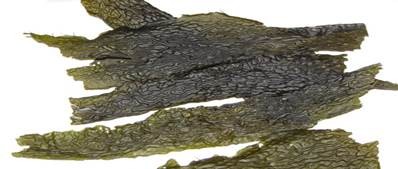Discover the amazing health benefits of this ancient SuperFood. Sea vegetables also have a broad range of medicinal uses and have been used in Spas and therapeutic Baths for ages.
Popular misconception: Seaweeds are fishy tasting.
Properly harvested, dried and stored Seaweeds do not acquire a fishy taste.
Seaweeds are high in nutrients and in general contain more Minerals than Vegetables, Meat, Milk or Eggs.
MINERALS: Sea vegetables are excellent sources of most Minerals, especially: Potassium, Sodium, Calcium, Magnesium, Sulfur, Nitrogen, Iron, Zinc, Boron, Copper, Manganese, Chromium, Selenium, Bromine, Vanadium, Nickel.
VITAMINS: Most sea vegetables are excellent sources of the known vitamins (A, B’s, especially B12, C, D, E, and K) as well as essential fatty acids. Powdered Bladderwrack has been mixed with olive oil as a safe effective alternative to cod liver oil.
I will introduce 5 Wild Seaweeds that we harvest in our area of North Coastal BC Canada
1) Bull Kelp (Nereocystis luetkeana)
Nereo Greek meaning mermaid Cystis greek meaning bladder, luetkeana is the species
Common names: Bullwhip Kelp, Ribbon Kelp, Sea Kelp
Taste: when dry it has fresh salty ocean taste.
How to use in food:
Bull Kelp once dried is one of the tastiest seaweeds. Fine and tender. Easy to eat. No cooking or soaking needed. It is usually used as a seasoning, sprinkled into foods such as Salads, Soups, Quinoa, Rice, Pasta etc. Also, enjoy eating kelp as a salty snack. It is on my list of favorite condiments.
Nutrition:
Rich in Calcium, Magnesium, Sodium, Iodine, Potassium, Bromine, Phosphorus, Iron, Bulk fibre, Vitamin A B complex, C D E and K.
Medicinal uses:
To treat Attention Deficit Disorder (ADD), Hyperactivity, Insomnia, Depression, Hostility, Schizophrenia, Minerals Depletion, Heartburn, Improves electrical nerve flow, Fibromyalgia etc.
Also used in Baths and Spas.
Place a handful of Kelp in a piece of cotton. Tie closed. Toss in hot bath. Squeeze gently and seaweed gel (Algin) will be released in bath water. Add gel to face for a Seaweed facial.
2) Kombu (laminaria spp.*) includes L. digitata Laminaria means thin leaf, digitata means finger
Common names: broadleaf kelp, devil’s apron, horsetail kelp, finger kelp
Taste: when dry is has a salty, natural monosodium glutamate taste. It is tough and once you chew it becomes slimy. Best when cooked.
How to use in food:
Chop in bite-size pieces and cook with your rice, quinoa, stews, beans (improves digestibility), shred and pickle. Roast and crumble on food.
Add a piece of Kombu (or Wakame) to beans at they cook. This will make the beans easier to digest and stop gas.: Beans, Beans and more Beans!
Nutrition:
High in Iodine, Calcium, Potassium, Magnesium, Iron, Sodium, Chromium, Protein, Mannitol, Phosphorus, Alginate, Fucoidan, Laminarin, Carotene, Phytohormones, Vitamin A, C, D, E, K and the B Complex Vitamins.
Medicinal Uses of Kombu:
Anti-viral, Relives sore joints and Muscles, Lowers high blood pressure, Improves sleep, Tissue healing. Treats certain thyroid problems, Aids weight loss, inhibits tumours, etc…
Also used in Baths and Spas.
Place a handful of Kombu in a piece of cotton. Tie closed. Toss in hot bath. Squeeze gently and seaweed gel (Algin) will be released in bathwater. Add gel to face for a Seaweed facial.
Recipes with Kombu:
Soba Soup: a Japanese favorite. A delicious noodle soup that is gluten-free and grain-free.
Lentil Soup: This savory soup has all the healthy benefits of the might lentil plus much more.
3) Bladderwrack (Fucus spp.*) includes F. gardneri F. Vesiculosus
Fucus Greek for seaweed. Bladder comes from the air-filled bulbs that resemble “bladders” Wracks name is from the Old English meaning Seaweed
Common names: pop weed, rockweed.
Taste: when dry it has a fresh oyster taste, hint of iodine. Very flavourful.
How to use in food:
Makes a mineral, iodine-rich broth, cook into rice, quinoa, seafood chowders, soups, stews. Soak, chop and cook into stir-fries.
Nutrition:
Rich in Iodine, Calcium, Potassium, Protein, Mannitol, Phosphorus, Alginate, Fucoidan, Phytohormones, Laminarin, Vitamins A, C, D, E, K and B complex
Medicinal Uses of Bladderwrack:
Stimulates the Thyroid, Detoxifies, Aids in weight loss, Fatigue, Strengthen the bones, Reduces Inflammation, Improves moods such as Anxiety, Depression, Forgetfulness, Fibromyalgia, etc…
Also used in Baths and Spas.
Place a handful of Bladderwrack in a piece of cotton. Tie closed. Toss in hot bath. Squeeze gently and seaweed gel (Algin) will be released in bathwater. Add gel to face for a Seaweed facial.
4) Giant Kelp (Macrocystis integrifolia), Greek meaning Macro large cystitis bladder
Common names: Pacific kelp, brown kelp
Taste: when dry: mild salty taste.
How to use in food:
Cook into soups, rice, quinoa, stews, beans, fish chowder, cut in thin strips and add to stir fry’s. Toast in a hot frying pan, no oil, takes only seconds. Eat like a chip.
Nutrition:
high in Algin, Mannitol, Potassium, Sodium, Calcium, Magnesium, Sulfur, Nitrogen, Iron, Zinc, Boron, Copper, Manganese, Chromium, Selenium, Bromine, Vanadium, Nickel; Vitamin A, B’s, B12, C, D, E, and K as well as essential fatty acids.
Medicinal Uses of Macrocystis:
Supports a healthy thyroid, Regulates hormones and metabolism, Supports the immune system, Antioxidant, Heart-healthy etc.
Also used in Baths and Spas.
Place a handful of Macro in a piece of cotton. Tie closed. Toss in hot bath. Squeeze gently and seaweed gel (Algin) will be released in bath water. Add gel to face for a Seaweed facial.
5) Wakame (Alaria spp.*) includes (Alaria marginata)
Alaria Greek for wing and wakame is Japanese for young girl.
common names: winged kelp
Taste: when dry: salty, savoury taste.
How to use in food:
Eat as a snack right out of the bag. Chop and cook into rice and quinoa, soups, casseroles, stews, beans, toast (and grind with a coffee mill) and sprinkle flakes on salads, sandwiches, rice, etc…
Nutrition: high in Calcium, Protein, Iron, Magnesium, Sodium, Phosphorus, Potassium, Chromium, Zinc, Iodine. Rich in B Complex Vitamins, Vitamin., A, C and K.
Medicinal Uses of Wakame: Discourages tumors, Detoxifying, Aids congestion, Lowers blood pressure, Nourishing to the liver, Purifies the blood, Prevents arteriosclerosis, Healthy for the skin and hair etc.
Also used in Baths and Spas.
Place a handful of Wakame in a piece of cotton. Tie closed. Toss in hot bath. Squeeze gently and seaweed gel (Algin) will be released in bath water. Add gel to face for a Seaweed facial.
Tasty Recipes with Wakame:
Miso Soup with Spinach and Mushrooms: Another eastern favorite.
White Bean and Asparagus Stew: Get your vegan protein with all the health benefits of asparagus here in one shot.
Enjoy your Sea Vegetables! This article is meant for information only. Consult a medical professional regarding medical problems and before making any major changes in your diet.
References:
Ryan Drum, PhD, AHG Website: www.ryandrum.com
Valerie Cooksley, RN, Author of Seaweed
(Nature’s Secret to Balancing Your Metabolism, Fighting Disease and Revitalizing Body & Soul)
Louis Druehl, Professor and Author of Pacific Seaweeds (a guide to common seaweeds of the West Coast)
*species
Article written by: Louise Gaudet/ Certified Wildcrafter and Owner of BC KELP (wild sea vegetables)
READ Inflammation: Is it Good or Bad for Your Body?
We hear about inflammation often but do we really know what it is? Inflammation is an important immune system function. When it is out of control, it can cause serious damage. Inflammation has been linked to major diseases such as Alzheimer’s, arthritis, cancer, diabetes, heart disease, and signs of aging. There’s good news: many foods are naturally anti-inflammatory. Adding Natural Anti-Inflammatory Foods to your meals is a very good way to reduce inflammation. Antioxidants found in foods protect your cells from the effects of free radicals and can help reduce an overabundance of inflammation in your body.







a garder
Excellent article! I am sharing it with Seaweed Pete’s health conscious audience! Sally
Comment…I very much enjoyed the topic.
great article
I am looking for the source of the Bull Kelp (with baby kelp) picture in the article above.
I would like to use it and am asking if it is copyrighted.
Hoping I get a response quickly
Contact Louise Gaudet, Owner of <a href="https://www.bckelp.com/">BC KELP </a>(wild sea vegetables) as this is her article.